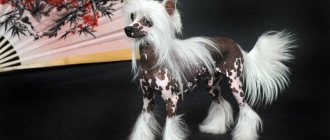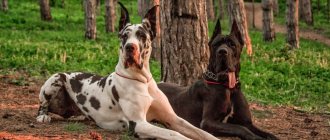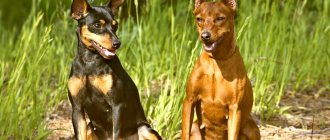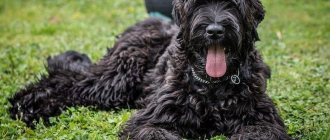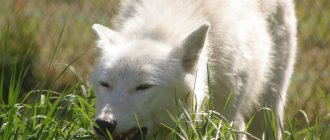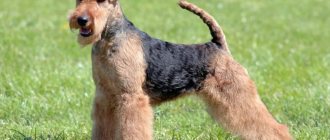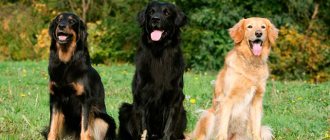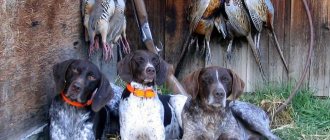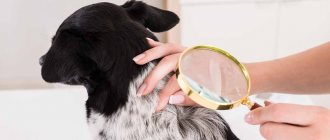a brief description of
- Other names: until 1888 - Spitzke, Spits, Spitske, later - Schipperke, schipperke, schipperke, spitt, spitsky, shepherd, black devil.
- Height: up to 36.0 cm.
- Weight: from 4.0 kg, preferably 7.0 kg, but not more than 9.0 kg.
- Color: black only.
- Coat: straight, hard, of medium length with a soft, but dense and dense undercoat.
- Life expectancy: up to 18 years.
- Advantages of the breed: attentive and extremely intelligent dogs are distinguished by courage and dexterity in managing herds. These little cowgirls are very confident in themselves. In addition, they are incorruptible and very vigilant. Children are treated kindly. Energetic dogs are highly trainable and understand everything perfectly.
- Difficulties of the breed: curiosity often borders on extreme curiosity. In addition, dogs tend to be dominant. The breed is characterized by excessive talkativeness, and barking is sometimes difficult to stop.
- Price: $800.
Appearance
The head is wedge-shaped, but not too long and fairly wide, balanced with the body. The muzzle tapers towards the nose, its length being about 40% of the total length of the head. The nose is small, black, lips are black. The eyes are dark brown, small, almond-shaped, not protruding, not sunken, sharp, lively gaze, black eyelids. The ears stand upright, very small, triangular (as close as possible in shape to an equilateral triangle), set high, but not too close to each other, very mobile.
The neck is strong, muscular, of medium length, seemingly voluminous due to the abundance of hair.
The body is short and wide, stocky, but not bulky and heavy, ideally fits into a square. The back is short, straight and strong. The tail is set high, and some dogs are born completely tailless or with a vestigial or short tail.
Limbs are straight, parallel, muscular. The thighs of the hind legs appear larger due to the abundant hair. The paws are small, round (cat's paw), with short black claws.
The coat is abundant, thick, straight and quite coarse, providing excellent protection along with a soft, dense undercoat. Very short hair on the ears and head. The hair on the body is of medium length, close-lying. Around the neck the hair is much longer and does not lie close to the body. Starting from the ears, especially in males, but also in females, the coat forms the collar (long hair around the neck, in tufts on both sides), mane (long hair on the top of the neck to the withers and shoulders), and frill (long hair on the underside). side of the neck and chest, extending between the paws and gradually disappearing on the underside of the chest). The long and luxuriant fur on the back of the thighs forms typical “pants.” The tail is covered with hair of the same length as throughout the body. The color is completely black. The undercoat may be dark gray if it is completely hidden by the topcoat.
Weight can be from 3 to 9 kg. Average weight 4-7 kg.
Origin of the breed
The Schipperke is an Old Flemish breed of small dog with a wolf-like appearance that has retained its phenotype for many centuries without any changes. The first written mentions of small black shepherds herding flocks of sheep date back to the 17th century, but the breed itself has more ancient roots.
According to one version, the Schipperke descended from the dark colored Levinar Sheepdog, and they can be classified as Continental European Spitz, since the phenotype with pointed, erect ears and a short, sharp muzzle is quite similar. The behavior and character, including the working qualities of the dogs, are similar.
The Schipperke has excellent guard, guard and hunting qualities. Dogs have long been used to kill rodents on barges and boats sailing along the Brussels Canal.
The favorites of shoemakers and ordinary workers from the Dutch suburbs were called Spit and Spitsk until 1888, when representatives of the breed received their modern name - Schipperke. The dogs first appeared at the London all-breed show, and a short time later the first breed standard was approved, allowing only black color in dogs.
Thanks to its rapidly increasing popularity, the English Breed Club opened two years later. Once in America, Schipperkes became favorites of ordinary people and happily played the role of companion dogs. And already in 1904, the breed was officially recognized by the American Kennel Club.
15 years later, at the end of 1920, the Unified Breed Standard was adopted, adopted on the basis of the Belgian regulations on the exterior of dogs. Unlike Europeans, in South Africa, the USA, Australia and New Zealand, any solid color of dog is allowed, including white, cream, blue, red and sable.
Origin and history of the breed
The Schipperke is the smallest representative of the Belgian Shepherds. Outwardly, it looks more like a Spitz, but it is a herding breed. These dogs presumably appeared in the 14th century, when Belgium, colonized by the French, passed a law banning the keeping of large dogs, except for the aristocracy. Therefore, ordinary residents were forced to use small dogs to perform guard functions. First came the Lueuwenar, and from him the Schipperke.
At the end of the 15th century, the breed had already spread massively throughout the country as a rat catcher and watchman. In 1690, the prototype of the first exhibition of these dogs took place thanks to Brussels workers. In subsequent years, intensive work has been carried out to improve the Schipperke. In 1882, the breed was recognized and admitted to exhibitions. In 1888 the first breed standard was approved.
There are several versions about the origin of the name. According to one of them, it comes from the word “Schipperke” (little captain), according to another, the name comes from the Flemish word “scheper” and means small shepherd dog.
At the end of the 19th century, Schipperke spread beyond Belgium. More of them end up in England. As a result of World Wars 1 and 2, the number of the breed decreased significantly. But thanks to the efforts of the breeders, she was restored. Today, the Schipperke is not on the list of the most popular and only ranks 102nd among registered breeds.
Purpose
The original purpose of small and strong, energetic Schipperkes who work almost tirelessly was to work on farms, where they were supposed to herd flocks of sheep. But over time, the nimble dogs beloved by river sailors became their constant companions, protecting the ships from rodents getting on board.
The Schipperke is generally recognized as the smallest shepherd dog . And to this day, these dogs are used in ground hunting for rabbits and in lifting game on the wing. Possessing goodwill, irrepressible energy and unpretentious living conditions, the Schipperke is considered an ideal companion.
For houses and apartments located in areas where the level of burglary is quite high, dogs of this breed are simply irreplaceable, as they are able to give a worthy rebuff to residential thieves.
Character
Based on the description of the breed, the character of the Schipperke is very strong, and at the same time quite absurd. not for nothing that they are called little devils. Natural independence, the desire for dominance, inquisitiveness that develops into exorbitant curiosity and the frankly absurd nature of a small dog turns the Schipperke into a large domestic monster if even minor mistakes are made in upbringing.
Fearless and courageous by nature, dogs are rightly called yard dogs, since shiperki control only the territory adjacent to the house, notifying the surrounding area with a ringing bark about the appearance of uninvited guests. If the pseudo-guests are persistent, then the dog has no trouble using his sharp, strong teeth, forcing the troublemakers to quickly retreat.
The dog feels sincere affection for the owner and his family. Dogs can tolerate children, but they are not nannies. The only thing a dog can do is look after children like sheep, not letting them near the gate and not giving them the opportunity to “stray from the herd.” They behave reservedly and non-aggressively with dogs of other breeds, but they consider it their direct responsibility to put the next bully in his place.
Notes
- Schipperk // Encyclopedic Dictionary of Brockhaus and Efron: in 86 volumes (82 volumes and 4 additional ones). - St. Petersburg, 1890-1907.
- ↑ 123
FCI Standard No. 83 dated 05/05/2003 (English) - ↑ 1 2 Falcon A.
Pembroke Welsh Corgi and his classmates. Schipperke // My friend the dog: magazine. - M.: Animal Press Publishing House LLC, 2013. - No. 2. - P. 20. - Schipperke. FCI Standard No. 83 (undefined)
(doc). Russian Cynological Federation. Date accessed: March 4, 2021. - Jean-Marie Vanbutsele.
The etymology of the word “Schipperke” (English).
DogDotCom
. Federation Cynologique Internationale. - Mishchikha O.
Lost in translation // My friend the dog: magazine. - 2012. - No. 1. - P. 60. - [1] (inaccessible link) (inaccessible link since 03/04/2017 [1466 days]), [2] Archived copy from April 26, 2009 on the Wayback Machine (inaccessible link since 03/04/2017 [1466 days]), [ 3] Archived copy from August 1, 2009 on the Wayback Machine (inaccessible link since 03/04/2017 [1466 days]).
Choosing a puppy
Schipperke litters are few in number - a female rarely gives birth to more than four puppies. When choosing a baby, the appearance of the puppy is of great importance:
- shiny fluffy coat without dandruff and bald patches;
- clean ears and genitals;
- clear eyes;
- high level of activity;
- fatness without excess body weight, a bloated abdomen, which may indicate the presence of worms in the intestines;
- confidence in movements;
- no lameness.
Schipperke puppies develop quickly, and at 45-50 days of age they are ready to move literally immediately after activation. The first thing people pay attention to when choosing a baby is the head, the fullness of the muzzle, the fit and length of the ears. By the age of one month, the ears usually begin to stand up. The puppy's format should be square.
The puppy must have documentary support - a birth certificate and a veterinary passport with vaccination dates. If a puppy is adopted at the age of five weeks, then it should already have two vaccinations. Puppies receive the third childhood vaccination at three months of age, if teeth have not begun to change by this time. If the moment is missed, the dog is vaccinated immediately after changing teeth, at the age of 5-6 months.
When purchasing a puppy, you need to get a full consultation from the breeder about feeding rules and the timing of the pet’s next worming.
Names and nicknames
The assumption that a pet's name depends on the zodiac signs was made by Donald Wolf, an American astrologer and part-time veterinarian. Therefore, you can take this aspect into account when choosing a name for the puppy.
For adherents of digital methods of choosing a nickname, we remind you that the total ratio of vowels and consonants of the letters of the animal’s nickname must be compatible with the owner’s name.
You should not lose sight of the fact that any name is a source of information , pronounced several times a day for a sufficiently long period of time, while the pet exists next to the owner. Therefore, the name given to the dog should be sonorous, pleasant to the ear, well remembered, and most importantly, the pet should like it.
Care and maintenance
Like all dogs, the Schipperke breed needs constant coat care , despite its small size and the inherent unpretentiousness of the breed to its living conditions. This breed, unlike other dogs, sheds three times a year. True, the shedding period lasts only ten days, but during this time the dog needs to be brushed daily. Dogs are not trimmed or cut.
Dogs should be bathed as rarely . Dogs who adore snow are great at cleaning themselves in snowdrifts. In the summer, they love to swim, so bathing procedures for dogs are carried out only in case of emergency.
The dental system of this ancient breed is strong, so a dental examination once a month is sufficient to prevent possible plaque formation. You should pay more attention to the Schipperke's eyes and ears. If lacrimation occurs, which is extremely rare, it is washed with special ophthalmic solutions. Ears are cleaned weekly without fail.
The main focus of dog grooming is on maintaining the pet's physical fitness. This is achieved through long active walks and controlling the amount of food, since representatives of the breed love to eat, and they eat everything that gets on their teeth.
Features of care
Combing
One look at the Schipperke's photo is enough to make you think about caring for his coat.
A lush frill around the neck and dense hair along the body suggest difficulties in caring for the dog’s coat.
However, don't despair. You don't have to brush your dog often with a furminator ; once every 2-3 weeks is enough.
Important! Schipperkes shed 3 times a year, the fur comes out profusely, so brush your pet twice a day during this period, with a brush with hard bristles.
It is better to use dry shampoo to wash your pet. It perfectly removes dirt, and you don’t have to resort to long drying of the animal.
The dog's nails are trimmed as they grow. Just keep an eye on their condition and trim off the excess as you go.
Check your ears after every walk. Severe pubescence of the inside of the ears provokes the retention of dirt, which can lead to the appearance of parasites.
If you want to learn more about how to clean your dog's ears, we recommend reading the article
It's good if you have the opportunity to walk with your dog in nature. Schipperkes are very energetic and nimble, they need jogging and active games.
Walk
Depending on where your pet lives, its walks are structured.
In a country house, a small Schipperke will run around the site to his heart's content, and you won't have to take him out on purpose.
When kept in a city apartment, the dog must be walked at least twice a day.
It's great if you have the opportunity to walk your dog in nature.
Schipperkes are very energetic and nimble, they need jogging and outdoor games like agility .
Confident and independent, the black baby Schipperke shows his character only in front of strangers; to his own he is always gentle and obedient
Nutrition
Just as with three times of molting, the Schipperke also presents surprises in nutrition. I would like to immediately note that some of them are pleasant.
For an adult Schipperke, one meal and a treat at night are enough.
If it seems to you that your pet is “starving” and you spoil him with plenty of feeding, expect your dog to become obese and have epileptic attacks. There are no serious problems in terms of diet either.
There are no taste preferences in the breed; dogs eat everything, so it depends on you how nutritious and healthy your pet’s food will be.
When feeding dry food, choose premium brands for small and active dogs.
Create a natural diet based on the physical condition of your dog.
Give meat, dairy products, vegetables, fish in strictly measured portions and do not indulge your beloved friend with food from the table, it is poison for him.
The Schipperke needs early socialization so that the adult dog does not bark at all passers-by and does not rush at the door with a growl when the bell rings or knocks.
Health and heredity
Physically strong dogs have excellent immunity. But among representatives of this breed, two extremely rare diseases that are inherited are common:
- Mucopolysaccharidosis type IIIB, or deficiency of a number of enzymes responsible for the breakdown of glycosaminoglycans.
- Chronic autoimmune lymphocytic thyroiditis, or degradation of the thyroid gland.
Both diseases are chronic, difficult to cure and occur as a result of a malfunction of the dog’s autoimmune system.
There is also a predisposition of some representatives of the breed to bone problems. With age, dogs may experience osteochondritis of the femoral head, as well as dislocation of the knee joint.
Cases of epileptic seizures among representatives of the Schipperke breed are extremely rare, but they are also attributed to the breed's predisposition to diseases in dogs.
Catering
Unpretentious in food, the Schipperke happily eats dry food, but does not disdain natural food. The main thing is to organize and provide a balanced diet not only during the period of raising the puppy, but throughout the pet’s life.
The choice of dry food should be focused on premium and super-premium food for active medium breed dogs. The daily amount of food consumed is calculated by the manufacturer and listed in the table on the back of the package.
A diet consisting of natural products should contain beef meat in an amount of at least 1/3 of the diet, as well as cereals, dairy products, vegetables and fruits. When it comes to fruits and vegetables, they are essential to any diet, whether for feeders or naturalists.
Education and training
The Schipperke, like no other breed, needs consistent training starting from a very early age. Representatives of the breed are characterized by a disgusting character trait, such as a rapid loss of interest in activities. If you repeat one exercise day after day, then literally on the third attempt the dog will simply refuse to perform it.
The key aspect in raising the smallest shepherd in the world is to prevent the dog from acting in a wayward way - acting as he pleases, following his own rules.
The essence of training comes down to the dog performing the basic functions of a guard - what nature has laid in it. But at the same time, you should wean yourself from excessive talkativeness. Stopping incessant barking is a major and difficult task for a trainer. It is important to teach your dog to bark exclusively about the visit of strangers, and not to express his joy at the appearance of familiar people.
Starting from the moment the puppy gets into a new home, they begin to educate him, teaching him to wear a diaper, until the post-vaccination quarantine ends. Next, go to the toilet while walking. Dogs have a certain desire to learn, but the main character trait is considered to be the desire to serve the owner. Therefore, during classes it is necessary to establish a trusting relationship between the owner and his dog.
As practice has shown, the best training for the Schipperke are agility, flyball and obedience classes. You shouldn’t discount the general training course, which starts when the puppy is six months or even eight months old.
But before this age, training the dog in primitive commands must be done independently. Since dogs develop late, they reach adulthood at three to four years of age.
Advantages and disadvantages
The greatest positive quality of Schipperke dogs is their unpretentiousness in maintenance and excellent health. They do not need comfort and can live in an enclosure thanks to their dense, thick undercoat.
The dogs learn quickly and are owner-oriented. Belonging to the working category, the breed needs to realize its natural qualities, and if they are provided to it, then one cannot ask for a better companion.
Sometimes the disadvantages include the cost of Schipperke puppies, the price of which is commensurate with the price of an old car. But the greatest disadvantage of the breed is the need to communicate with the owner, especially during the formation of the dog’s psychological stability at the age of 3-15 weeks.
Lack of communication leads to the suppression of the breed's character traits inherent in nature. Such dogs are poorly socialized, do not want to learn, and are vicious.
An unrealized Schipperke is capable of fighting with all pets and people living under the same roof with him, aggressively greets guests, and provokes conflict situations during a walk.
Content Features
The Schipperke will feel best in a private house with a yard. By the way, the site should be well fenced. Blackies overcome a variety of obstacles with ease and enthusiasm, love to make tunnels, and even the electronic fence popular in the West cannot become an obstacle to adventure. Schipperkes get along well in an apartment, provided they have good walking. They tolerate frosts well, but they have a slightly worse time in extreme heat. Therefore, in the summer it is important to take all measures to prevent heat stroke. Schipperkes are very hardy; they can live in an enclosure in winter, but due to their nature, they will not be happy outside alone.
Schipperkes are very playful and energetic, so they need daily walks lasting about 2 hours. A walking pace is not suitable for them, they need to be given the opportunity to run, outdoor games and activities are encouraged. A small dog can even become a jogging companion. A bored Schipperke acquires bad habits that manifest themselves in obsessive and destructive behavior. On walks, it is worth remembering the dog’s curiosity and pronounced hunting instinct, which makes it chase neighbor’s cats, squirrels, other small animals, and birds.
Care
Schipperkes do not require complex care. During the molting period, the coat is combed daily, helping the dog to quickly get rid of the undercoat and overripe guard hair; the rest of the time, once a week is enough. Bath only if necessary, if the dog is very dirty, before a show or every 3-4 months.
It is important to teach the independent Schipperke from early childhood that hygiene procedures are a normal part of his life and must be accepted patiently. During the process, the owner must maintain a positive attitude and avoid fuss.
Other mandatory hygiene procedures include trimming nails, cleaning ears and teeth. Claws are trimmed as they grow. The auricle is checked weekly for redness and unpleasant odor, and if necessary, cleaned of accumulated wax and dust.
Nutrition
Schipperkes are often picky eaters if they are pampered and offered a choice of food from early childhood. It is better for the owner to decide in advance what he will feed the dog. These can be natural products, ready-made dry and wet food, or raw food according to the BARF system. In any case, you need to approach the issue of nutrition wisely, observing calorie content and regimen.
It is not advisable to feed such an active dog immediately before walking or exercising; after eating there should be rest.
Reviews
Sonya:
He may be small, but he is a shepherd with a slightly restless character. I agree that it’s loud, but I’m always aware when guests come to me. My girl just pretends to be happy. He can't do it any other way.
Elena:
Unfortunately, the breed is very poorly known in our country. We are often mistaken for a mongrel or a mixed breed. We have to tell you that our baby is the son of titled parents and, of course, about the characteristics of the breed. So to speak, we are engaged in popularization.
Oleg Lvovich:
My dislike for small dogs was overcome by our Bonya, a Schipperke, brought from Germany. We were not disappointed in our choice for a second, having ignored all the doubts from our dog handler friends. A person must talk to the dog himself to decide whether it is his breed or not.
We ask everyone who is not indifferent to the Schipperke breed, which is still little known in our country - the little black devil, as the ancient Dutch called it, to share their observations and experiences with these amazing dogs. If you tell us stories from your life, about the peculiarities of training, as well as the nuances of training - anything that will help us decide on the choice of breed, we will be immensely grateful. Leave your comments at the bottom of the article. We are waiting for your stories.
Share
Leave a review
Schipperke breed standard
FCI Standard: №15
FCI name: Schipperke Other names: Schipperke (Schiperke), Schipperke
Country of origin: Belgium
Purpose
The Schipperke is a small guard dog, a companion dog.
FCI Classification Group 1. Guard and racing dogs (except Swiss Cattle Dogs). Section 1. Shepherd dogs. No operational tests. General form
The Schipperke is a very compact, stocky dog of small size. The head is wedge-shaped, with a well-developed skull and a fairly short muzzle. The Schipperke's body is balanced, short, fairly wide and squat, the limbs are thin-boned. A characteristic feature of the breed is the coat. The Schipperke's coat is abundant, harsh to the touch, and straight. Forms a lush “collar”, mane, “jabot” and feathering in the form of lush “pants”, which gives the dog its unique contour. Males are noticeably different from females. The simple morphology of the Schipperke, combining the character and temperament of a shepherd, as well as its compact size explain the wide popularity of this breed, which has long gone beyond the borders of Belgium.
Important proportions
— The height at the withers is equal to the length of the body, due to which the Schipperke has a square format. - The chest is low, reaching to the level of the elbows. — The length of Schipperke's muzzle is significantly less than half the length of the head.
Behavior
The Schipperke is an excellent small guard dog, radiates energy and vitality, and is wary of strangers. The Schipperke is an active, cheerful and active dog, agile, tireless, interested in everything that happens around. When a stranger approaches a protected object, it tends to bite. Schipperke is kind and affectionate with children. Inquisitive and inquisitive. Strives to find out what is happening behind a locked door, what is hidden behind a moving object, etc. When danger approaches, Schipperke reacts with a deafening bark and raises his mane. A good hunter of rats, moles and other rodents.
Head The Schipperke's head is wedge-shaped, but not too long, wide enough to remain in proportion to the body. The brow ridges and cheekbones are moderately pronounced. The transition from the forehead to the muzzle in Schipperke is visible, but not overly pronounced.
Skull part Schipperke's forehead is quite wide, tapering towards the eyes, and slightly rounded when viewed from the side. The upper lines of the skull and muzzle are parallel.
The transition from forehead to muzzle is pronounced, but not excessive.
Facial region Nose Small, black.
Muzzle The Schipperke's muzzle tapers towards the nose; clear lines, not too long, not truncated at the end; leaves about 40% of the total head length; with a straight bridge of the nose.
Lips Black, tightly fitting.
Teeth Schipperke's teeth are healthy, correctly set, with a scissor bite, a straight bite is allowed. Complete set - in accordance with the dental formula. In Schipperke, the absence of one or two premolars (1 PM1 or 2 PM1) or premolar 2 (1 PM2) is allowed; molars 3 are not taken into account.
Cheekbones The Schipperke is characterized by cheekbones of clean lines that imperceptibly flow into the sides of the muzzle.
Eyes Schipperke's eyes are dark brown, small, almond-shaped. Neither convex nor sunken at the same time. Schipperke's gaze is mischievous, lively, and sharp. The edges of the eyelids are black.
Ears The Schipperke breed is characterized by straight, erect, very small, pointed ears of a triangular shape (if possible, in the shape of a maximum equilateral triangle), set high, but not too close to each other. Solid and extremely mobile.
Neck Strong, with powerful muscles, due to the lush, thick collar, it looks very impressive and very voluminous, of medium length, harmoniously articulated with the shoulder blades at the base. Alert, Schipperke raises his neck, slightly bending his topline.
Body Schipperke's body is short and wide, stocky, but not bulky or heavy. The shape fits perfectly into a square. The length of Schipperke's body from the humeroscapular angle to the ischial tuberosity is approximately equal to the height at the withers.
Topline The Schipperke's topline of the back and loin is straight, strong, and often slightly raised from the croup to the withers.
Withers Schipperke's withers are clearly pronounced, and due to his thick mane they seem even larger.
Back Short, straight, strong.
Loin Schipperke's loin is short, wide, and powerful.
Croup Schipperke has a short, wide, horizontal croup; the rear part of the body, namely the articulation of the croup with the ischial tuberosity, is pleasantly rounded - the so-called guinea pig croup shape.
Chest Descends to elbow level; wide in front and behind the shoulder blades; with noticeably rounded ribs. When looking at Schipperke from the side, the front of the chest is clearly defined.
The hemline descends to the elbows, rising harmoniously and gently to the level of Schipperke's moderately tucked abdomen, which is neither saggy nor sunken at the same time.
Tail Absent; Schipperke's undocked tail is long, wide at the base, tapering towards the end, reaching at least to the hock joint. When at rest, it preferably hangs down, slightly curving at the end. When in motion, the Schipperke's tail may rise to the level of the topline, preferably no higher. The set of the tail should not interrupt the line of the croup, which smoothly merges with the harmoniously rounded hip, which creates the impression of a “guinea pig croup.” A curled tail is acceptable for the Schipperke, but not desirable.
Limbs With dry bones, placed under the body.
Forelegs General appearance Schipperke's forelimbs are straight when viewed from any side, and absolutely parallel when viewed from the front; the length of the limbs from the ground to the elbows is about half the height at the withers.
Shoulder blades Schipperke's shoulder blades are long, inclined, with a standard angle of articulation.
Shoulders Long, with a proportionate slope.
Elbows Schipperke has strong elbows, turning neither in nor out.
Forearms Straight, when viewed from the front, quite widely spaced.
Wrists The Schipperke is characterized by strong, non-bulging wrists.
Pasterns Quite short, when viewed from the front they continue the line of the forearm, when viewed from the side of Schipperke they have a very slight slope.
Paws The Schipperke has small, round and compact paws (called cat paws), with curved toes and short, strong, black claws.
Hindquarters General appearance Schipperke's hindquarters should be located under the body and, when viewed from behind, be absolutely parallel to the forelegs.
Hips Schipperke's hips are long, very muscular, and due to the fringes they are visually wider than they really are.
Knees (knee joints) Located approximately in line with the thigh; have a standard articulation angle.
Tibia Schipperke's tibia are approximately the same length as the femur.
Hock joints With a standard articulation angle.
Hocks Quite short; Schipperke's dewclaws are undesirable.
Paws Completely similar to the front paws or slightly longer.
Movement When the Schipperke trots, the movement is flexible, steady, with a moderate reach and good drive from the hindquarters. The topline remains horizontal, the limbs move parallel to each other; The movements of the front and hind legs are harmonious, the elbows should not be turned outward. At higher speeds, Schipperke's limbs converge.
Leather Tightly fitting over the entire surface of the body.
Coat Schipperke's guard hair is abundant, thick, straight and quite hard, stable texture, dry. The coat is hard, strong, of medium length, straight, with a soft, dense undercoat, in no way soft, wavy or wiry - it gives the dog excellent protection. The hair on Schipperke's ears is very short. The hair covering the dog's head, the front of its forelimbs, hocks and metatarsals is short. The coat of the Schipperke's body is dense and of medium length. On the neck, the hair is much longer, starts at the outer edge of the ears and forms a wide collar, characteristic of this breed (long hair, luxuriantly encircling the neck), especially pronounced in males, a mane (long hair in the upper part of the neck, turning into the hair of the withers and even the shoulder blades), as well as the “jabot” (long hair on the lower part of the neck and chest, covering the area between the forelimbs and gradually disappearing below chest level). The back of the Schipperke's thighs is covered with long, abundant hair and forms the typical feathering of this breed. The hair on the tail is the same length as on the entire surface of the body.
Color Completely black. The Schipperke's undercoat must also be completely black, dark gray is allowed, but provided that it is completely hidden under the guard hair.
Weight From 3 to 9 kg. Average weight is 4 – 7 kg (desirable standard). A Schipperke weighing less than 3 kg or more than 9 will not be able to receive the highest score.
Disadvantages Any deviation from the above points is considered a defect, the degree of which is determined by how much it differs from the standard.
General appearance Untidy, not “knocked down” enough, Schipperke’s limbs are too long or too short, the body is long, rectangular in format.
Head Too long or too short Schipperke head. The lines of the skull and muzzle are not parallel, “fox face”; too prominent eyebrows and zygomatic arches.
Skull box Too narrow; Schipperke's forehead is too rounded or domed (apple-shaped).
Muzzle Too long, pointed; thick, truncated; convex topline.
Dental formula A serious defect in Schipperke is considered to be unevenly distributed or poorly placed incisors, the absence of one incisor (1 I), three first premolars (3 PM1) or two second premolars (2 PM2).
Eyes Large, round or bulging eyes of a light color (in Schipperke light brown color is allowed).
Chest Narrow, flat, or cylindrical. Not lowered enough.
Croup Long, sloping, with a rise, not round in shape (transition from the croup to the back of the thighs). Schipperke limbs with too small or too large an angle of articulation.
Movement Too narrow, Schipperke's stride too wide, poor drive, soft back, front reach too high, hindquarters jumping.
Coat Too short (close to the body), too long, too fine, soft or silky, wavy, lying too flat or hanging down; insufficiently lush or completely absent collar, insufficiently lush or completely absent mane, insufficiently lush or completely absent feathers (in Schipperke males this defect is considered more serious, especially the absence of a collar). Insufficient undercoat.
Color The guard hair has markings of grey, brownish or reddish tint. The presence of random white hairs in Schipperke, for example, on the fingers. Older dogs may have a small amount of gray hair, for example on the face.
Temperament Lethargic or timid.
Grounds for disqualification Schipperke's behavior is nervous, aggressive or excessively fearful.
General appearance: Inconsistency with the breed type.
Teeth Undershot or overshot in Schipperke, including without loss of contact, misalignment of the jaw, absence of one canine (1 C), one molar (1 M1 or 1 M2, but not M3), one fourth premolar (lower PM4), one third premolar 3 (1 PM3) plus one more tooth, or the absence of a total of 4 or more teeth (with the exception of the four first premolars).
Nose, lips, eyelids Absence or lack of pigment in Schipperke.
Ears Drop or half erect.
Coat Long or soft, silky, i.e., clearly a long-haired type of coat; fringes of long hair on Schipperke's ears, behind the limbs, etc.; complete absence of undercoat.
Color All colors except black (with the exception of markings of gray, brownish and reddish shades), or the presence of small white spots on the Schipperke, including on the toes.
Weight Clearly outside the specified standard.
Any dog showing signs of deviation from physical or behavioral norms is subject to disqualification.
Schipperke males must have two normally developed testes, fully descended into the scrotum.

